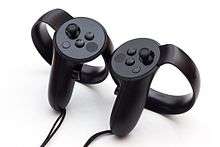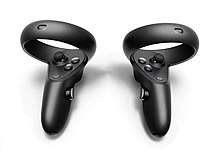Oculus Touch
Oculus Touch is the motion controller system used by Oculus VR in their Rift, Rift S, and Quest virtual reality systems. Two iterations of the controllers have been developed; the first for use in the original Oculus Rift, which uses external tracking, and the second one for use with the Rift S and the Oculus Quest, which use inside-out tracking.

Hardware
The Oculus Touch consists of a pair of handheld units, each featuring an analog stick, three buttons, and two triggers (one commonly used for grabbing and the other for shooting or firing), and features a system for detecting finger gestures the user may make while holding them.[1] The ring in each controller contains a set of infrared LEDs, which allows the controllers to be fully tracked in 3D space by the Oculus Rift's Constellation system, allowing them to be represented in the virtual environment.[2] Each controller features a rumble motor for haptic feedback, and is powered by a single AA alkaline cell.
History
First iteration

The first iteration of Oculus Touch was revealed on June 11, 2015 with a prototype called the Half Moon. The prototype used the same infrared LED tracking technology as the Oculus Rift and included inward-facing sensors which could detect common hand gestures.[3]
Since the Oculus Rift was initially shipped without motion controllers, the Oculus Touch was first released as a standalone accessory for the Rift. Pre-orders for Oculus Touch began on October 10, 2016, with priority granted until October 27 to those who had originally pre-ordered the Oculus Rift.[4] The device was finally released on December 6, 2016.[5] Besides the two controllers, this standalone bundle included an extra Constellation sensor, to accompany the one included with the first release of the Oculus Rift. Later, in August 2017, the standard Rift bundle was modified, the Oculus Touch, with its second sensor, became an integral part of the Oculus Rift bundle.
Second iteration

A second revision of the controller was released in March 2019, included with both the Oculus Rift S and the Oculus Quest. The most prominent modification is that, now designed to work with these devices' inside-out tracking, the controllers' IR rings were moved to the upper side of the device, to ensure their visibility from the headset's tracking cameras. Due to an oversight, the first batch of these controllers made it to developers and even retail including "easter egg" messages in the interior of their shell.[6]
References
- Elyse Betters. "What is Oculus Touch and how does it work with the new Oculus Rift?". Pocket-lint. Retrieved June 17, 2015.
- Josh Constine. "Oculus Previews "Oculus Touch" Handheld Motion-Tracking Haptic Controllers". TechCrunch. AOL. Retrieved June 17, 2015.
- Lang, Ben (11 June 2015). "Oculus Reveals 'Oculus Touch' Half Moon Prototype VR Input Controller". Road to VR. Retrieved 18 October 2019.
- Makuch, Eddie (6 October 2016). "Oculus Touch Controllers Cost $200, Release Date Announced". GameSpot. Retrieved 11 December 2016.
- "Oculus Touch Launches Today!". Oculus VR. 2016-12-06.
- "Oculus Quest & Rift S Controllers Could Hide an Unintended Easter Egg Message Inside". 2019-04-13.